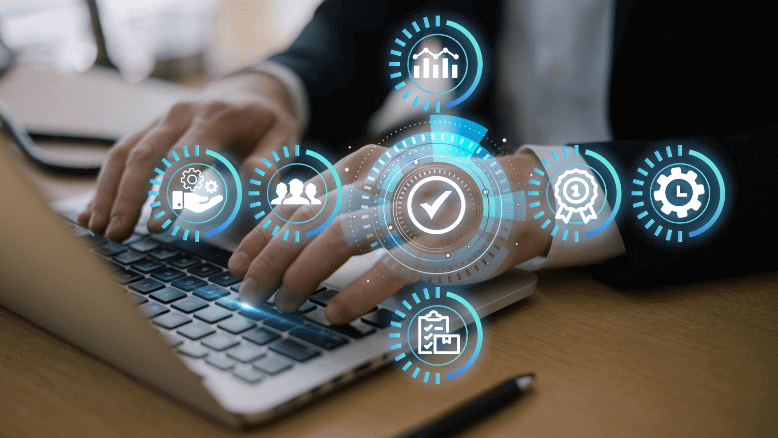5 Margin Multipliers for CFOs in Manufacturing to Protect Gross Margin Levels

5 Margin Multipliers for CFOs in Manufacturing to Protect Gross Margin Levels
Are you a CFO in manufacturing grappling with the relentless challenge of margin erosion? You’re not alone.
Margin erosion isn’t mythical, it’s a real and pressing issue that can silently bring even the strongest manufacturing operations to a grinding halt.
Margin erosion is the gradual decline in gross margin that can slowly undermine your company’s financial stability if left unchecked.
In today’s fast-moving business environment, where everything from supply chain complexity to market volatility is constantly shifting, understanding and addressing margin erosion is crucial.
It’s not merely a financial metric but a reflection of how well your business can adapt to changing conditions and maintain profitability.
Why does Margin Erosion happen?
To effectively combat margin erosion, we need to understand what it is and what causes it.
When the difference between sales and the cost of goods sold (COGS) gets smaller over time, it is called margin erosion. But why does it happen?
- Pricing Pressure: When competitors aggressively cut prices, it can force your hand to lower prices as well, leading to reduced margins. It’s a constant battle to balance competitive pricing with profitability. Intense competition can lead to pricing wars, reducing your gross margins.
- Cost Increases: Rising costs for raw materials, labor, and other inputs directly impact margins. Inflation and increased operational expenses mean that every dollar spent reduces the margin between costs and revenue.
- Inefficient Operations: When inventory isn’t managed well and resources are wasted, operational costs can skyrocket. Often, these inefficiencies go unnoticed until they become a huge financial burden.
A study from McKinsey found that companies using digital tools can boost production by 10% to 30%.
- Changing Customer Preferences: The market’s preferences can shift quickly. If your product lineup doesn’t adapt to these changes, you risk becoming irrelevant, which affects your ability to maintain healthy margins.
As consumer demands shift, manufacturers must adapt. An Accenture research reveals that 64% of consumers wish companies would respond faster to meet their changing needs.
Add economic downturns, fluctuating currency rates, and evolving state of regulations to the above challenges and you are in the midst of a perfect storm. You are often introduced to unforeseen costs and operational challenges, squeezing margins further.
How can CFOs combat Margin Erosion?
To tackle margin erosion effectively, CFOs in manufacturing should focus on these strategies:
- Gross Margins & Sales Rewards: Let’s start by making gross margins the heart of your sales rewards program. They should be the first thing you see on sales reports and the guiding star for compensation plans.
When margins take center stage, your team knows what truly drives success. Burying them at the bottom is a missed opportunity. Tie commissions and bonuses directly to margin goals, as this keeps profitability not just a priority but the priority.
- Cost Optimization and Efficiency: This strategy is not new but is unmissable. Reducing operational costs is crucial.
For instance Nucor, a leading steel producer has implemented a highly efficient mini-mill production process to keep things efficient by using electric arc furnaces to melt scrap steel, which is a lot cheaper than traditional blast furnaces.
This smart move, along with just-in-time inventory management, helps Nucor stay profitable.
- Take control of Inventory: Inventory management is crucial for your company’s financial health. Holding too much inventory can tie up cash, leading to liquidity issues and eating into your profits.
An “Open to Buy” program is a great tool for this. It helps you manage your spending, ensuring you clear out old stock before adding new items. This keeps you from buying too much and keeps your cash flow on track.
- Indirect spends directly impact Margins: Take a close look at every line in your general ledger; knowing exactly where your money goes, whether it’s for consultants, marketing, shipping, or maintenance fees is crucial.
Forming a committee to review these expenses quarterly can help keep everything in check. You can also partner with E2E supply chain automation & procurement automation solution providers like Moglix.
Moglix through its award-winning cloud SaaS platform and catalog-based buying model can give you better visibility into indirect spending and speed up your digital transformation journey at a rapid yet sustainable pace.
- Artificial Intelligence will drive efficiency: According to a survey published on Forbes.com, nearly two-thirds of CFOs (65%) are integrating AI into their long-term strategies, yet many are still figuring out how to use it effectively.
For CFOs, AI can be a game-changer in safeguarding gross margin. Using predictive analytics lets you foresee market changes, so you can tweak your pricing or inventory as needed.
Interestingly, though these tools offer great benefits, only 49% of CFOs feel “very knowledgeable” about generative AI as per the above-mentioned survey.
So, we’ve covered some key strategies to fight margin erosion. But let’s be honest—CFOs in manufacturing are already familiar with some other common tactics.
We’re not going over the basics like product mix optimization, value-based pricing, risk management strategies, supplier relationships, or dynamic pricing.
You’re already familiar with those. These are solid strategies you likely use already.
Staying Ahead in the Margin Game
As we move forward, CFOs in manufacturing must embrace a proactive approach to combat margin erosion. This means staying flexible, using new technology, and adjusting to market changes.
By encouraging a culture of innovation and teamwork, CFOs can protect their margins and turn challenges into growth opportunities. The future is for those who can foresee changes and adapt quickly.
Moglix’s integrated procurement saas solution, automated workflows, and catalog-based buying solutions, combined with its state-of-the-art physical warehouse network could be a “one ring to rule them all” partner for CFOs in manufacturing.
Click here to know more.
UAE’s Journey to Net-Zero Emissions through Sustainability

UAE’s Journey to Net-Zero Emissions through Sustainability
As the UAE continues to experience significant growth and progress, it has also realized the impact of its actions on the environment. With the highest per capita carbon footprint globally, the country has acknowledged the need to prioritize sustainability for the well-being of its citizens and the planet. The UAE has set impressive targets to achieve net-zero emissions by 2050 and reduce greenhouse gas emissions by 23.5% by 2030, demonstrating a deep commitment to the cause.
UAE has already declared 2023 to be the ‘Year of Sustainability’, with a focus on implementing sustainability practices like raising the capacity for renewable energy, enhancing energy efficiency, and lowering waste across multiple industries. It has taken important steps to reduce its carbon footprint and promote sustainability.
One of the most notable initiatives is Masdar City in Abu Dhabi, which has set the goal of being carbon-neutral and zero-waste. This incredible urban development utilizes clean, renewable energy sources like solar and wind power and promotes sustainable transportation options such as electric vehicles and public transit.
It is heavily investing in renewable energy projects, such as the Mohammed bin Rashid Al Maktoum Solar Park, which is one of the largest solar energy projects globally. The country’s target of generating 50% of its electricity from renewable sources by 2050 is ambitious but achievable with the UAE’s continued commitment.
The Dubai Metro, a sustainable transportation option that operates on renewable energy, is yet another example of the UAE’s dedication to sustainability. The government has also implemented several other initiatives to encourage renewable energy, sustainable transportation, and eco-friendly infrastructure, furthering the country’s commitment to a more sustainable future.
The UAE, being a major hub of trade, is taking significant steps towards reducing its carbon footprints in the supply chain industry. To achieve this, they are adopting green logistics practices such as providing efficient routing and scheduling, utilizing green transportation systems, promoting sustainable packaging, and implementing green practices in warehouses. Furthermore, it is also prioritizing supply chain sustainability by managing resources sustainably, reducing the use of hazardous materials, promoting sustainable production methods, and ensuring responsible and ethical sourcing of materials and products. By adopting these measures, the UAE is promoting a more sustainable approach to the production and distribution of goods, while also reducing their environmental impact.
According to the World Economic Forum,” Energy, materials, and mobility, which are the top 3 carbon-emitting industries, can reduce emissions by 4-10% by 2030 with an increased focus on the adoption of digital technologies.” Moglix supports the UAE’s vision to become a carbon-neutral economy by 2050. We have been enabling organizations to digitally transform the procurement supply chain process at a rapid yet sustainable pace.
Contact us to know how we can empower your transformation journey!
Building Strong Supplier Relationships in UAE for Business Growth

Building Strong Supplier Relationships in UAE for Business Growth
Supplier relationship management is an integral part of every supply chain, no matter what part of the world your business is in. For companies in the UAE, supplier relationship best practices may be particularly crucial since the region is among the top importers in the world. Moreover, reductions in global trade barriers have made it possible for companies in the middle-east to source materials, goods and services from various top exporters in the world, like China, India, the USA and Japan.
If your business is established in the UAE, strong relationships with vendors across borders can help you scale up quickly. Supplier relationships in the UAE also impact the procurement supply chain in many ways, as outlined below.
Vendor relations in the procurement supply chain
Here are the key benefits of vendor relationship best practices for your supply chain over the long term.
- It encourages supplier-led innovation
- It results in cost savings by eliminating the need to set up new contracts
- It helps form partnerships with suppliers whose goals align with yours
- It strengthens your supply chain and reduces fragmentation of the product procurement
- It improves operational efficiency by eliminating shortages and maverick purchases
Five tips for building and maintaining strong supplier relations in the modern world
Building good relations with your suppliers is tough, and maintaining them can be tougher still. Nevertheless, here are some industry best practices you can adopt to boost your supplier relationship management.
- Keep the lines of communication open
- Understand what your suppliers offer
- Choose vendors whose offerings align with your needs
- Draw out detailed and precise contracts to eliminate ambiguity in your dealings
- Uphold your end of the contract and pay your dues on time
Digitization: The need of the hour to tackle challenges in supplier relationships today
Supplier relationship management can be fraught with issues like a weak SRM strategy, failure to align supplier-client priorities, poor communication between the parties involved and even trouble enforcing the contracts involved.
Digitization and e-procurement can be revolutionary game-changers here. With digital transformation elevating your SRM practices, you can screen suppliers more effectively and partner with the right vendors. It also facilitates better communication with your vendors and leaves little room for ambiguity in contract management.
Build and maintain supplier relationship with experts
Managing supplier relationships in the UAE is a continuous process that needs to be updated periodically to keep pace with industry best practices. An expert procurement and supply chain partner like Moglix can help you navigate this evolving requirement, leaving you free to focus on your core business. Know How
3 reasons to perform procurement spend analytics

3 reasons to perform procurement spend analytics
What are you buying? Whom are you buying from?
How much have you spent on it, and how do the outlays compare to last year?
As an e-procurement professional today, these are only some of the many questions you will need the answers to. This is because monitoring and managing spend across the supply chain are integral to procurement leadership. And spend analytics can help you here.
What is spend analytics in procurement?
Spend analytics is gathering data related to an organization’s expenses, sorting, grouping and classifying that data, and then analyzing it to gather meaningful insights on where every penny goes. The end goal is to optimize costs and maximize profits.
3 key reasons you need procurement spend analytics
Spend analytics is pivotal in controlling and optimizing expenses in the procure-to-pay cycle. Here are 3 key reasons procurement leaders of today should prioritize this process.
1. Improved spend intelligence
With a robust spend analytics program, you get improved visibility of the costs incurred on procurement. Spending intelligence such as this can be crucial to reviving and optimizing your business supply chain. It also allows you to make more confident spending decisions because you are aware of how much your business is spending.
2. Easier identification of savings opportunities
E-procurement coupled with spend analytics also makes it possible for you to identify the areas that hold great potential for cost savings. By cost-cutting where you can and having a flexible procurement budget where needed, your business can benefit from incremental savings that stem from smart expense optimization.
3. Better supplier relationship management
Vendor management is pivotal to building profitable supplier relationships across the procurement cycle. And the information gathered from your data analytics processes can be invaluable in this regard. As a procurement professional today, you can use the insights gathered to partner with suppliers who meet specific criteria, promote supplier development, and build better relationships with your vendors.
Another challenge that procurement managers face is understanding KPIs they need to track to understand spends better. The key performance indicators (KPIs) to measure the effectiveness of your organization’s procurement spend analytics include:
● Cost savings
● Category-wise spending
● Supplier performance
● Vendor management
● Operational KPIs
Optimize your procurement with world-class spending analytics
Moglix offers intelligent spend benchmarking solutions that allow you to compare your procurement expenses with industry benchmarks and optimize your spending. Contact us today to know more about how our spend analytics solutions can help you on your path to absolute digital transformation.
Make the transition to sustainable procurement with this 5-step guide

Make the transition to sustainable procurement with this 5-step guide
With ESG business practices gaining prominence worldwide, sustainable procurement may be more relevant than ever for your business. In theory, sustainable procurement is simple enough; it involves integrating ESG factors into your organization’s supply chain and procurement process. When done right, sustainable procurement can improve your brand reputation, promote better supplier relationships and increase profitability.
Data from the World Economic Forum shows us that sustainable business projects may lead to cost savings of 9% to 16% and can increase revenue by up to 20%. Research by Hackett also reveals that around 92% of companies are already poised to have a sustainable procurement program by 2023.
Your business can also join this league by adopting an immediate and effective action plan to make procurement more sustainable as we journey into a new year.
A simple, 5-step plan to achieve sustainable procurement
Here is what your business can do to make the transition from conventional to sustainable procurement faster and more effective.
1. Identify the critical areas in your supply chain.
Whether you follow conventional sourcing practices or have partial e-procurement implemented in your business, the first step to sustainability involves identifying the areas that matter. For most organizations, the critical areas in the supply chain include sourcing, negotiations, contract management, vendor management and payment, thus completing the procure-to-pay cycle.
2. Evaluate and define sustainable criteria for your business procurement
Once you have identified the key areas in your procurement cycle, evaluate how sustainable (or unsustainable) they are. This will give you a clear idea of how far you have come and how much you need to go. You can then define the sustainable criteria you must meet in each critical area of your supply chain.
3. Perform supplier due diligence
Supplier due diligence may be just as crucial as supplier relationships in the journey to a more sustainable future. Before you sign a contract with a potential supply partner, evaluate their commitment to sustainability and assess if you have shared business values. In the long run, this will make vendor management much more accessible and help you progress more quickly on the path to sustainability.
4. Develop the roadmap for sustainable sourcing
The next step to sustainable procurement is developing a roadmap that makes your strategy for the future clearer and easier to implement. First, identify the critical business practices you want to focus on to future-proof your supply chain sustainably. Automation, paperless contract management, digital transformation and strict adherence to your organization’s ESG goals are essential pillars of your strategy.
5. Roll out your plan and review it periodically.
To complete the action plan towards a more sustainable procurement process, you need to roll out your developed strategy and monitor its implementation. For best results, it is advisable to review your plan periodically, identify weak areas, if any, and work on strengthening sustainable practices within your procurement department.
Want to accelerate the shift to e-procurement and sustainability?
Moglix can help you with this. Our end-to-end procurement solutions can overhaul your supply chain procurement strategies an help on your path of digital transformation, while keeping in mind your sustainability goals. Contact us today to learn more about how this works
The ever-evolving landscape of supply chain trends

The ever-evolving landscape of supply chain trends
Businesses have not remained immune to the waves of challenges brought forth by the pandemic. Across sector lines and international boundaries, organizations have had to innovate to survive the new normal and, eventually, thrive.
The New Normal
From supply chain constraints to repeated halts in operations, businesses have had to contend with an array of bottlenecks during this unprecedented time ridden with a global pandemic and the war in Ukraine. One of the major trends to emerge has been organizations’ increasing reliance on technology and digital procurement.
Since every link in the value chain has been adversely affected due to a host of reasons, including supply-side shortages, demand-side stagnation, and a general environment of uncertainty, the path to recovery has been forged with equal parts resilience and restraint.
Upcoming Supply Chain Trends for 2022
Due to the dynamic nature of the supply chain, the trends are ever-evolving and hence unpredictable. However, here are some of the key supply chain trends that surfaced in 2021 and are expected to stay true in 2022:
Widening the value chain basket: One of the main learnings for organizations during the pandemic is the lacunae caused by overreliance on one or two supply chain partners. Businesses are increasingly putting their eggs in different baskets by collaborating with a wider range of suppliers, marketers, and distributors. Though this means increased business coordinations, negotiations etc. across the value chain, organizations that enable seamless digital procurement have come to the industries rescue through their ability consolidate scattered vendor base on a single platform
1. Technology and automation to the rescue: In the wake of the pandemic, businesses are emphasizing leveraging technology to achieve higher accuracy in demand forecasting, production planning, and marketing strategy. Artificial Intelligence and Machine Learning are increasingly being applied to ensure minimal disruptions in the supply chain. Data generated with the help of these emerging technologies are being constantly employed to identify potential areas of growth in business.
2. Building resilience against the global logistics disruption: The widespread disruption of the global logistics chain has caused businesses severe headaches and compelled them to build resilience to production delays, raw material shortfalls, and extremely volatile demand trends. This has driven a drastic restructuring of the supply chain for the better.
3. Supply Chain Trends in the UAE
Being a key member of the GCC, the UAE has robust free trade associations with several countries. In addition to this, the country has bilateral trade agreements with India, The Netherlands, etc. Recently, UAE announced its intention to deepen its ties with growing economies. Some of its business negotiations with countries like India, Turkey, and Indonesia seem to indicate a positive trend in this direction.
Some of the recent supply chain trends in the الإمارات العربية المتحدة are:
- A rise in the prominence of e-commerce and related logistics
- Growth of the pharmaceutical sector
- Easing of duties on import-exports
- Growth of bilateral agreements for trade
The Foreign Trade Ministry of UAE feels that these trade pacts are bound to increase foreign direct investment and enhance business growth in terms of volumes.
Choose Moglix To Stay Ahead of the Curve
The outlook for the UAE logistics market seems to hint at a robust 6.5% CAGR projection for the period of 2022-2027. With supply chain trends picking up pace in what we see as a potential post-pandemic world, it is important for businesses to stay ahead of the curve in order to maximize value.
If you are looking to transform your supply chain and focus on digital procurement, Moglix can help you stay ahead of the curve. We aim to optimize strategic procurement and bring in supply chain efficiency for organizations across various sectors, including manufacturing, infrastructure, and Oil and Gas in the UAE.
Equipped with what is said to be future facing technology and dynamic capabilities such as Integrated Procurement Solutions, Automated Workflows, and Catalog-Based Buying, Moglix ensures that you can take your organization’s operations to the next level by enhancing efficiency and maximizing cost-effectiveness. Visit our website to know more.
Strategies To Address Procurement Woes In a Volatile Supply Chain Market (Turning Chaos Into Control)

Strategies To Address Procurement Woes In a Volatile Supply Chain Market (Turning Chaos Into Control)
Part Two – The Solutions
As discussed earlier in part 1 of this blog, the global COVID-19 pandemic and ongoing war have forced organizations to withstand a highly volatile supply chain environment. The prevailing procurement environment is costlier due to the exponential rise in the cost of shipping and increased operational costs. In addition to these reasons, continuing exclusive use of the existing legacy technologies and switching to spot bidding for logistics by the organizations are adding burden to the businesses. As a wise option for surviving the highly volatile supply chain environment, businesses should turn their focus to digital procurement and technology.
From Chaos to a Semblance of Control
Faced with an array of challenges, including higher costs of freight, reduced revenue, extreme pressure on bottom lines, and persistence with obsolete legacy systems, businesses are increasingly turning to technology and digital procurement to ensure their supply chain and sourcing strategies can keep up with the high volatility of the market.
Here are some of the solutions businesses are adopting to attain excellence in their logistics management.
1. Evolution, Adaptation, and Responsiveness: A high degree of volatility in the supply chain and the business environment calls for a correspondingly high degree of adaptation on the part of businesses. This is why most businesses are switching to Dynamic Market Sourcing.
As opposed to Traditional Cycle Sourcing, its dynamic counterpart enables organizations to constantly assess the market, have better communication with their supply chain partners, and manage the ever-changing landscape of freight costs, and the influx of new suppliers.
2. Leveraging technology to stay ahead of the curve: In this day and age, businesses are largely driven by data. With high fluctuations on the demand and supply side alike, businesses must leverage technology and data-based insights to be as dynamic and adaptive as possible.
From better demand forecasting to an increased emphasis on automation, there are myriad ways through which the challenges of a highly volatile supply chain can be met head-on and with success.
3. Risk management: Risk is an integral facet of any business, and the higher the accuracy of risk assessment is, the higher an organization’s chances to mitigate risks in an efficient manner. One of the key strategies in managing supply chain-related risks is having multiple suppliers instead of one or two.
Another solution is to always be prepared by analyzing market trends and conducting what-if analyses. This way, your organization can be well placed to deal with a high-risk situation. Risk assessment is, in many ways, akin to an airbag in a vehicle. It protects your business from potential crashes.
The Future of Supply Chain
You can now bring digital procurement to the forefront of your business and excel in a highly volatile supply chain environment by relying on Moglix’s Integrated Procurement Solutions, Automated Workflows, and Catalog-Based Buying Solutions, amongst others, to revolutionize your business’s approach to logistics. To know more, visit our website.
Strategies To Address Procurement Woes In a Volatile Supply Chain Market (Turning Chaos Into Control)

Strategies To Address Procurement Woes In a Volatile Supply Chain Market (Turning Chaos Into Control)
Part One: The Challenges
Change is the only constant and the global COVID-19 pandemic had brought this universal truth home in an unprecedented manner. Businesses across the globe had found themselves faced with severe supply chain and sourcing challenges, leading to higher volatility and higher risk. In the face of such bottlenecks, traditional approaches to supply chain and logistics management were no longer effective or feasible.
Viability amidst volatility
It is no secret that one of the things that make businesses thrive is stability in processes. The pandemic and the ongoing war, however, disturbed the very foundations of stability and compelled organizations to withstand a highly volatile supply chain environment. Here are some of the challenges faced in the prevailing procurement environment:
1. Building capacity is now costlier: One of the main characteristics of the present sourcing market is the exponential rise in the cost of shipping. The rise in container freight and air freight has made it drastically difficult for businesses to build and sustain capacity and stability. For instance, before the pandemic struck the world, the freight for the China to USA route was around $1,500 (for a 40-foot container). This price is now anywhere between $10,000 to $15,000, making it financially nonviable.
2. Preserving the bottom line is now harder: With the rising cost of materials as well as shipping costs, organizations are increasingly grappling with higher operational costs. The problem is exacerbated by the constant decline in demand and, in turn, revenues. The combined effect is a significant drop in the bottom line of organizations.
3. Continuing with Legacy technologies: At a time when digital procurement is being looked at as a key driver to solve businesses’ supply chain woes, several organizations are still continuing with old and obsolete legacy systems. Not only are those systems time-consuming and cost-heavy, but they are also non-responsive to factors such as price compression, capacity changes, etc.
4. Switching to spot bidding for logistics: Traditionally reliant on annual freight contracts with low prices, businesses now have to manage the necessary switch to spot pricing in logistics. The restrictions in the capacity and movement of air cargo in the wake of the pandemic have brought spot price bidding to the fore, placing a higher than ever before pressure on their operational costs.
The Bottom Line
In order to survive and thrive amidst a highly volatile supply chain environment, businesses must turn to digital procurement and technology. This is where Moglix can help you transform your business through our Catalog Based Buying, Automated Workflow, Enhanced Visibility, and Integrated Procurement Solutions. Know more on our website.
